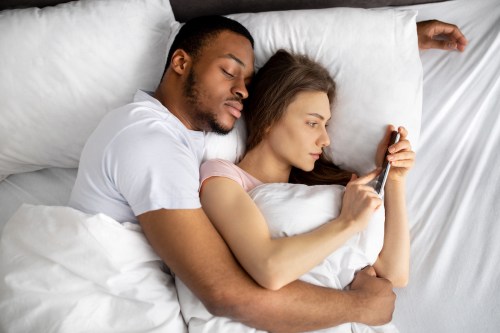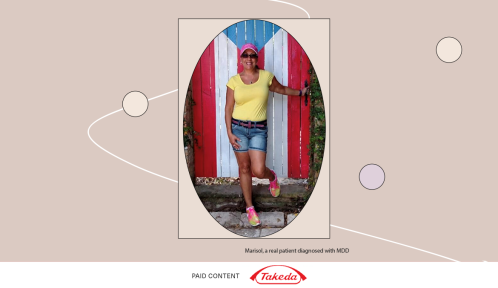Is Mirror-Touch Synesthesia Real? The Pain and Pleasure of Physical Empathy
Mirror-touch synesthesia is a real condition that creates tactile sensations in a person's body when they see someone else being touched.

Whenever my dogs accidentally bump their heads on the coffee table, I swear I can feel the pain radiating through my skull. It’s either a sign of empathy or that I’m an over-protective dog mom, but most likely a combination of the two. Empathy is the ability to imagine yourself in someone’s place and understand what they’re experiencing. People with a neurological condition called mirror-touch synesthesia, however, aren’t just cringing at the thought of pain. They’re actually experiencing it.
Experts in This Article
co-founder of VMeDx
clinical neuropsychologist and founder and clinical director at Elements Psychological Services, LLC
licensed clinical psychologist, neuropsychologist, and founder of Duality Psych Services
This phenomenon can occur in response to pain—like watching someone in a movie run into a door—as well as pleasure and neutral touch. If they “see another person receiving a hug or pat on the shoulder, they feel that same physical sensation, even though no one has actually touched them,” says Joel Frank, PsyD, a clinical psychologist and owner of Duality Psychological Services. While this may sound too surreal to be true, a 2013 study published in the Oxford Library of Psychology indicates that between 1.5 and 2.6 percent of the general population have mirror-touch synesthesia.
With our curiosity piqued, we asked neuroscience experts about this rare and fascinating phenomenon. To what extent can someone experience physical pain through mirror-touch synesthesia? Does their connection with the individual experiencing the actual physical sensation play a role in transmitting these sensations? And what can mirror-touch synesthesia tell us about the human capacity for empathy? Read on to learn about the signs of mirror-touch synesthesia, its potential causes, and how it can affect a person’s daily life.
Is mirror-touch synesthesia real?
Synesthesia occurs when the activation of one sense simultaneously activates another sense, says Jessica McCarthy, PsyD, clinical neuropsychologist and founder and clinical director at Elements Psychological Services, LLC. For example, people with this condition may see a certain color when they hear a musical note or associate words with different tastes and textures. A person can be born with synesthesia or develop this condition because of a brain injury or drug use. Mirror-touch synesthesia is the most common type of synesthesia and refers to when “a person experiences the same physical sensations that they observe someone else experiencing,” Dr. McCarthy says. The term “mirror” describes sensations that occur on the opposite side of the body. For instance, if they see someone receiving an injection in their left arm, someone with mirror-touch synesthesia might feel pain or discomfort in their right arm. “This heightened sensory experience often translates into intense emotional and physical empathy for others’ joy and pain,” Dr. Frank says. They might tear up or feel a warm embrace while watching a parent comfort their child. What they observe can feel very personal and immediate.
There are no specific diagnostic criteria that professionals have formulated to determine the scope of mirror-touch synesthesia in an individual, making it tricky to study and track. That said, doctors typically treat the condition as a sensory processing disorder, in which the brain has trouble receiving and communicating information obtained through the five senses. Generally, sensory processing disorders can create motor-processing issues, making it difficult to move the body in response to sensory signals, spatial issues that make it difficult to navigate your environment, sequencing issues that make seemingly simple tasks more complex, and more. Mirror-touch synesthesia, specifically, makes it hard for the mind to discern between another individual being touched and the self being touched. Because it captures visual data that confirms someone is being touched, the mind communicates to the body that the someone must be the self. The severity of the transmitted sensation varies from person to person, with some experiencing just an “echo” of a touch when they see someone stub their toe and others experiencing full-blown pain as if they were the one to bump into the coffee table.
To those who don’t experience it, mirror-touch synesthesia typically comes across as a heightened version of empathy, which is usually good because it allows us to build social connections and understand others on a deeper level. These elevated levels of physical empathy, though, can make someone vulnerable to sensory overload. Dr. Frank explains that crowded spaces can be overwhelming due to the physical sensations triggered by observing people’s movements. While a day at the beach might sound fun to some, someone with mirror-touch synesthesia might dread going to a place where they might witness a child scrape their knee, another person get sunburned, and someone else get salt water in their eyes.
How to test for mirror-touch synesthesia
Mirror-touch synesthesia is diagnosed through self-reporting, as well as clinical evaluation by a neurologist or psychologist, says Gregory Gasic, PhD, co-founder of VMeDx. According to a 2022 study, approximately 10.8 percent of the population report having mirror-touch synesthesia1 while the estimated prevalence, based on objective tests, is 1.6 percent—on the lower end of the 1.5-2.6 percent range found in the previous study. Self-reported symptoms include itching, tingling, pressure, or pain upon seeing another person being touched.
“This heightened sensory experience often translates into intense emotional and physical empathy for others’ joy and pain.” —Joel Frank, PsyD
Structured clinical assessments “typically involve detailed questionnaires and interviews to gather comprehensive information about the frequency, consistency, and context of the experienced sensations,” Dr. Frank says. The clinician may show videos or live demonstrations of people being touched and ask the individual to report any corresponding sensations. In addition, a person may undergo imaging tests to determine if their symptoms are consistent with mirror-touch synesthesia. Functional MRIs can be used to observe brain activity in response to visual stimuli, as well as detect structural differences in the brain. Individuals with mirror-touch synesthesia may show heightened activity in brain areas associated with vision and touch, Dr. Gasic says.
What causes mirror-touch synesthesia?
Although research hasn’t established the cause of this condition, mirror neurons are likely involved. Mirror neurons are “specialized brain cells that activate when an individual performs an action and when they observe someone else doing the same action,” Dr. Frank explains. Among people with mirror-touch synesthesia, these neurons might be hyperactive or more interconnected, meaning they tend to feel what they’re observing.
Another theory is that the brain has a hard time differentiating between the self and others, or what’s known as “self-other theory,” Dr. McCarthy explains. Essentially, their brain interprets other people’s physical experiences as happening in their own bodies. These perceptions are so vivid, they feel like physical sensations and can’t be thought away. At times, they make people with mirror-touch synesthesia so uncomfortable in their bodies that they will physically cringe or groan in pain if they witness someone else getting hurt, even if it’s on TV or in a TikTok video.
A third possibility is “cross-activation between the brain’s sensory and visual areas,” Dr. Frank says. This can result in more than one sense being activated at a time, so observing touch can feel like they’re being touched. In addition, their heightened sensory perception makes them more adept at interpreting and empathizing with other people’s actions, Dr. Gasic says. While each of these theories is similar, no individual theory fully explains why some people experience mirror-touch synesthesia and more research is needed to fully understand the scope of the condition.
Is mirror-touch synesthesia linked with empathy?
Some studies suggest that people with mirror-touch synesthesia tend to display heightened empathy2. Their hyperactive mirror neuron system converts visual information into physical sensations, strengthening their social and cognitive recognition skills, Dr. Gasic says. For example, one study found that people with mirror-touch synesthesia were skilled at reading facial expressions3 of emotions but had normal scores on other measures of empathy. A 2019 study5 even suggests that people with mirror-touch synesthesia display more unselfish behaviors and generally put others before themselves, potentially as a result of this heightened empathy.
Other studies haven’t been able to replicate these findings, including a 2016 study4 which found that people with mirror-touch synesthesia did not score higher on measures of empathy compared to other groups. They also concluded that mirror-touch synesthesia may co-occur with autism at higher rates than previously thought. One possibility is that the symptoms of autism are often overlooked, particularly when they present in women, so these individuals may be misdiagnosed as having synesthesia instead of autism, Dr. McCarthy explains.
Given these mixed findings, perhaps it’s more accurate to describe the relationship between mirror-touch synesthesia and empathy as being complex and multifaceted. Since their mirror neurons seem more active, they can easily simulate and empathize with other people’s experiences. This shows an extraordinary level of empathetic connection that goes beyond imagining or comprehending someone’s feelings, Dr. Frank says.
How to cope with mirror-touch synesthesia
For someone with mirror-touch synesthesia, having heightened empathy and sensory experiences can promote deeper connections and compassion in their relationships. Some people may enjoy their sensory experiences, channeling them into creative and artistic pursuits, Dr. McCarthy says. In other instances, these sensations can lead to sensory overload, making the experience of touch seem overwhelming and difficult to enjoy.
Practicing self-care can help minimize the effects of sensory overload. For example, you can pre-emptively consider situations where you tend to experience intense sensations, so you can anticipate and manage them more effectively. You can also work on setting personal boundaries, such as taking breaks during social gatherings or using noise canceling headphones to minimize sensory input, Dr. Frank suggests. Another way to help calm your mind is by incorporating deep breathing and five-minute meditation exercises into your daily routine.
If mirror-touch synesthesia is detracting from your enjoyment of life, all three experts recommend seeking support from a healthcare professional like a neurologist or psychologist who can help validate your experiences, Dr. McCarthy says. They can offer strategies like mindfulness and cognitive behavioral techniques for managing sensory overload. You can also join a support group or online forum, so you can share experiences and receive advice from people with similar conditions, Dr. Gasic says.
Since the constant influx of mirrored sensations can be overwhelming, it’s also important to be honest with your friends and family about your experiences. Open communication can promote support and understanding. Mirror-touch synesthesia is rare and can be difficult to understand if you haven’t experienced, so take the time to share your unique perspective with the world for your own benefit, as well as to help others appreciate the complexities of the human experience.
- ↩︎
Gillmeister, Helge, et al. “Touching You, Touching Me: Higher Incidence of Mirror-Touch Synaesthesia and Positive (but Not Negative) Reactions to Social Touch in Autonomous Sensory Meridian Response.” Consciousness and Cognition, vol. 103, Aug. 2022, p. 103380, https://doi.org/10.1016/j.concog.2022.103380.
- Santiesteban, Idalmis et al. “Atypical emotion sharing in individuals with mirror sensory synaesthesia.” Cognitive neuropsychology vol. 40,7-8 (2023): 367-380. doi:10.1080/02643294.2024.2353581↩︎
- Ward, Jamie et al. “The relationship between mirror-touch synaesthesia and empathy: New evidence and a new screening tool.” Cognitive neuropsychology vol. 35,5-6 (2018): 314-332. doi:10.1080/02643294.2018.1457017↩︎
- Baron-Cohen, Simon et al. “Mirror-Touch Synaesthesia Is Not Associated with Heightened Empathy, and Can Occur with Autism.” PloS one vol. 11,8 e0160543. 4 Aug. 2016, doi:10.1371/journal.pone.0160543↩︎
- ↩︎
Ioumpa, Kalliopi, et al. “Enhanced Self-Reported Affect and Prosocial Behaviour without Differential Physiological Responses in Mirror-Sensory Synaesthesia.” Philosophical Transactions of the Royal Society B: Biological Sciences, vol. 374, no. 1787, 21 Oct. 2019, p. 20190395, https://doi.org/10.1098/rstb.2019.0395.










